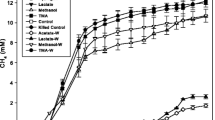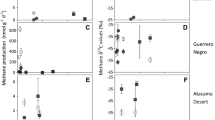Abstract
The sulfate-reducing bacterium strain SRB D2 isolated from the photic zone of a hypersaline microbial mat, from Lake Chiprana, NE Spain, respired pyruvate, alanine, and α-ketoglutarate but not formate, lactate, malate, succinate, and serine at significant rates under fully oxic conditions. Dehydrogenase enzymes of only the former substrates are likely oxygen-tolerant as all substrates supported anaerobic sulfate reduction. No indications were found, however, that aerobic respiration supported growth. Although strain SRB D2 appeared phylogenetically closely related to the oxygen-tolerant sulfate-reducing bacterium Desulfovibrio oxyclinae, substrate spectra were markedly different. Most-probable-number (MPN) estimates of sulfate-reducing bacteria and aerobic heterotrophic bacteria indicated that the latter were numerically dominant in both the photic and aphotic zones of the mat. Moreover, substrate spectra of representative isolates showed that the aerobic heterotrophic bacteria are metabolically more diverse. These findings indicate that sulfate-reducing bacteria in the fully oxic photic zone of mats have to compete with aerobic heterotrophic bacteria for organic substrates. Porewater analysis revealed that total carbohydrates and low-molecular-weight carbon compounds (LMWC) made up substantial fractions of the total dissolved organic carbon (DOC) pool and that nighttime degradation of the former was concomitant with increased concentration of the latter. Our findings indicate that aerobic respiration by sulfate-reducing bacteria contributes to organic carbon mineralization in the oxic zone of microbial mats as daytime porewater LMWC concentrations are above typical half-saturation constants.




Similar content being viewed by others
References
KL Anderson TA Tayne DM Ward (1987) ArticleTitleFormation and fate of fermentation products in hot-spring cyanobacterial mats Appl Environ Microbiol 53 2343–2352
MM Bateson DM Ward (1988) ArticleTitlePhotoexcretion and fate of glycolate in a hot-spring cyanobacterial mat Appl Environ Microbiol 54 1738–1743
P Caumette Y Cohen R Matheron (1991) ArticleTitleIsolation and characterization of Desulfovibrio halopilus sp. nov., a halophilic sulfate-reducing bacterium isolated from Solar Lake (Sinai) Syst Appl Microbiol 14 33–38
T Clarke N Owens (1983) ArticleTitleA simple and versatile micro-computer program for the determination of ‘‘most probable number’‘ J Microbiol Methods 1 133–137 Occurrence Handle10.1016/0167-7012(83)90031-3
H Cypionka (2000) ArticleTitleOxygen respiration by Desulfovibrio species Ann Rev Microbiol 54 827–848 Occurrence Handle10.1146/annurev.micro.54.1.827
H Cypionka F Widdel N Pfennig (1985) ArticleTitleSurvival of sulfate-reducing bacteria after oxygen stress, and growth in sulfate-free oxygen-sulfide gradients FEMS Microbiol Ecol 31 39–45 Occurrence Handle10.1016/0378-1097(85)90045-X
S Dannenberg M Kroder W Dilling H Cypionka (1992) ArticleTitleOxidation of H2, organic-compounds and inorganic sulfur-compounds coupled to reduction of O2 or nitrate by sulfate-reducing bacteria Arch Microbiol 158 93–99 Occurrence Handle10.1007/BF00245211
W Dilling H Cypionka (1990) ArticleTitleAerobic respiration in sulfate-reducing bacteria FEMS Microbiol Lett 71 123–128 Occurrence Handle10.1016/0378-1097(90)90043-P
TA Hansen (1994) ArticleTitleMetabolism of sulfate-reducing prokaryotes Ant van Leeuw 66 165–185 Occurrence Handle10.1007/BF00871638
J Heijthuijsen TA Hansen (1986) ArticleTitleInterspecies hydrogen transfer in cocultures of methanol-utilizing acidogens and sulfate-reducing or methanogenic bacteria FEMS Microbiol Ecol 38 57–64 Occurrence Handle10.1016/0378-1097(86)90042-X
HM Jonkers R Ludwig R DeWit O Pringault G Muyzer H Niemann N Finke D Beer Particlede (2003) ArticleTitleStructural and functional analysis of a microbial mat ecosystem from a unique permanent hypersaline inland lake: ‘‘La Salada de Chiprana’’ (NE Spain) FEMS Microbiol Ecol 44 175–189 Occurrence Handle10.1016/S0168-6496(02)00464-6
BB Jørgensen (1994) ArticleTitleSulfate reduction and thiosulfate transformations in a cyanobacterial mat during a diel oxygen cycle FEMS Micobiol Ecol 13 303–312 Occurrence Handle10.1016/0168-6496(94)90068-X
D Krekeler P Sigalevich A Teske H Cypionka Y Cohen (1997) ArticleTitleA sulfate-reducing bacterium from the oxic layer of a microbial mat from Solar Lake (Sinai), Desulfovibrio oxyclinae sp. nov Arch Microbiol 167 369–375 Occurrence Handle10.1007/s002030050457
D Krekeler A Teske H Cypionka (1998) ArticleTitleStrategies of sulfate-reducing bacteria to escape oxygen stress in a cyanobacterial mat FEMS Microbiol Ecol 25 89–96 Occurrence Handle10.1016/S0168-6496(97)00085-8
DR Lovley EJP Phillips (1992) ArticleTitleReduction of uranium by Desulfovibrio desulfuricans Appl Environ Microbiol 58 850–856 Occurrence Handle1575486
W Ludwig O Strunk S Klugbauer N Klugbauer M Weizenegger J Neumaier M Bachleiter KH Schleifer (1998) ArticleTitleBacterial phylogeny based on comparative sequence analysis Electrophoresis 19 554–568 Occurrence Handle10.1002/elps.1150190416 Occurrence Handle9588802
G Muyzer A Teske CO Wirsen HW Jannasch (1995) ArticleTitlePhylogenetic relationships of Thiomicrospira species and their identification in deep-sea hydrothermal vent samples by denaturing gradient gel electrophoresis of 16S rDNA fragments Arch Microbiol 16 165–172 Occurrence Handle10.1007/s002030050250
SC Nold DM Ward (1996) ArticleTitlePhotosynthate partitioning and fermentation in hot spring microbial mat communities Appl Environ Microbiol 62 4598–4607
I Obernosterer GJ Herndl (2000) ArticleTitleDifferences in the optical and biological reactivity of the humic and nonhumic dissolved organic carbon component in two contrasting coastal marine environments Limnol Oceanogr 45 1120–1129
HW Paerl BM Bebout SB Joye DJD Marais (1993) ArticleTitleMicroscale characterization of dissolved organic-matter production and uptake in marine microbial mat communities Limnol Oceanogr 38 1150–1161 Occurrence Handle11539296
Revsbech, NP(1994) Analysis of microbial mats by use of electrochemical microsensors: recent advances. Stal, LJ, Caumette, P (Eds.) Microbial Mats. NATO ASI Series, Vol G35, pp 135–147
P Sigalevich Y Cohen (2000) ArticleTitleOxygen-dependent growth of the sulfate-reducing bacterium Desulfovibrio oxyclinae in coculture with Marinobacter sp. strain MB in an aerated sulfate-depleted chemostat Appl Environ Microbiol 66 5019–5023 Occurrence Handle10.1128/AEM.66.11.5019-5023.2000 Occurrence Handle11055958
NL Thakur U Hentschel A Krasko CT Pabel AC Anil WEG Müller (2003) ArticleTitleAntibacterial activity of the sponge Suberites domuncula and its primmorphs: potential basis for epibacterial chemical defense Aquat Microbial Ecol 31 77–83
HG Trüper HG Schlegel (1964) ArticleTitleSulphur metabolism in Thiorhodaceae. I. Qualitative measurements in growing cultures of Chromatium okenii Ant Leeuw 30 225–238
GJC Underwood DM Paterson RJ Parkes (1995) ArticleTitleThe measurement of microbial carbohydrate exopolymers from intertidalf sediments Limnol Oceanogr 40 1243–1253
EWJ VanNiel JC Gottschal (1998) ArticleTitleOxygen consumption by Desulfovibrio strains with and without polyglucose Appl Environ Microbiol 64 1034–1039
EWJ VanNiel TMP Gomes A Willems MD Collins RA Prins JC Gottschal (1996) ArticleTitleThe role of polyglucose in oxygen-dependent respiration by a new strain of Desulfovibrio salexigens FEMS Microbiol Ecol 21 243–253 Occurrence Handle10.1016/S0168-6496(96)00060-8
F Widdel (1988) Microbiology and ecology of sulfate- and sulfur-reducing bacteria AJB Zehnder (Eds) Biology of Anaerobic Microorganism John Wiley & Sons New York 469–585
F Widdel F Bak ((1992) Gram-negative mesophilic sulfate-reducing bacteria A Balows HG Truper M Dworkin W Harder KH Schleifer (Eds) The Prokaryotes EditionNumber2 Springer-Verlag New York 3353–3378
Author information
Authors and Affiliations
Corresponding author
Rights and permissions
About this article
Cite this article
Jonkers, H., Koh, IO., Behrend, P. et al. Aerobic Organic Carbon Mineralization by Sulfate-Reducing Bacteria in the Oxygen-Saturated Photic Zone of a Hypersaline Microbial Mat. Microb Ecol 49, 291–300 (2005). https://doi.org/10.1007/s00248-004-0260-y
Received:
Accepted:
Published:
Issue Date:
DOI: https://doi.org/10.1007/s00248-004-0260-y




